
Jeep car cover is not a makeshift sheet you toss on whenever the sky looks bad. Think of it as a portable microclimate that surrounds your Jeep, where every fabric layer, every cut, and every hem has a job to control water, wind, dust, heat, and humidity. In the United States, a Wrangler, Gladiator, or Grand Cherokee does daily duty and also takes you to red-dirt trails, rocky lots, desert wind and dust, open parking with morning sprinklers, and long Snow Belt winters with snow and road salt. If you wait for damage to appear and then try to rescue it with washing, polishing, and water-spot removal, you will always be behind the problem. A more proactive way is to understand why damage happens, what it leaves behind over time, and where a Jeep car cover that works on the right mechanisms should intercept that chain of causes.
Related Articles: Jaguar car cover: protecting Nappa leather, wood veneer, and panoramic glass to preserve color
Why Jeep needs a multi-environment cover instead of one that is only thick or only waterproof
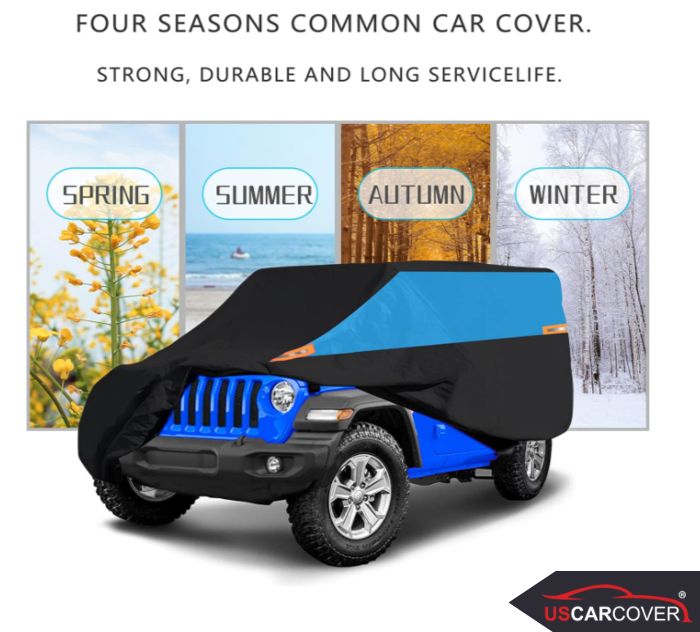
When you step into the Jeep world, you accept a design philosophy that puts open, durable experience first. High ground clearance, large approach and departure angles, a rigid body, removable doors and roof, soft tops with soft windows, hard tops with large glass areas, steel bumpers, winches, roof racks, and snorkels bring you closer to the elements. That openness also means exterior and interior surfaces are exposed directly to UV, dust, mud, rain, snow, and salt. Over time, seemingly mild factors build a damage chain: paint develops micro swirls from dust and dried mud rub, glass shows white mineral halos from evaporated droplets, chrome dulls and pits, seals age, the cabin runs hot and picks up a faint musty smell.
An effective Jeep car cover does not win by being extremely thick. It wins by managing conditions. The outer skin must make droplets bead and slide quickly to shorten wet time. The middle core must be one-way breathable, letting vapor go out from underneath without letting rain come down. The inner lining must be ultra soft so every contact is a cushioned touch that is safe for paint, hard glass, and the soft windows of soft tops. Above all, the whole cover must hold a stable form with correct cutting, recessed seams, and soft hems so it stays still in wind, avoiding balloon-collapse cycles that drag dust like an ultra-fine sandpaper. When these four factors work together, the cover does more than hide the car. It removes the conditions that cause damage in the first place.
Related Articles: Isuzu car cover: Is it really necessary to handle night rain, early sun, and daytime dust
Red mud: the mess washes off, but micro swirls are the hidden cost
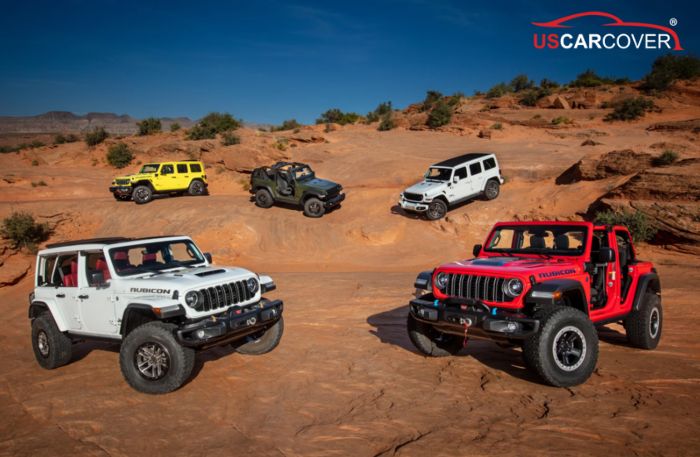
After red-dirt trails, you see grime and a quick wash makes it look clean. The real problem is the dried mud particles rich in iron oxides that bond tightly and are quite hard. If the cover is loose, every gust makes it swell and collapse, sliding those particles lightly across the paint like micro sandpaper. The first time it is invisible. After a few weeks, the metallic hood shows a shimmering web of micro swirls under sunlight. The remedy is paint correction that thins the clear coat and costs hours.
The deep cause is repeated friction. The consequence is a surface that ages season by season. The fix is to eliminate repeated friction. A Jeep car cover with a stable form stays put in wind thanks to cuts matched to Wrangler, Gladiator, Grand Cherokee, Renegade, and Compass. Recessed seams hide fabric edges at corner transitions. Soft hems avoid imprinting edges onto upright glass. Combined with a beading surface, light rain or a quick rinse turns mud into round droplets that slide along the slopes of hood, glass, and fender arches, reducing the chance of drying into a crust. If your habit is short mid-day stops, a half cover that shades glass and roof prevents dragging fabric across dried mud on the flanks, cutting the risk of micro scratching from rushed handling.
Related Articles: International car cover: comprehensive protection, small investment for big savings
Desert dust and strong wind: every gust can turn a loose cover into a dust sail

In desert environments, fine dust contains hard, sharp silica. Trouble begins when a cover swells and collapses with each gust. The fabric pulls dust back and forth over paint and glass, eroding the surface gradually. You may not notice at first, but under angled light you see dense micro swirls, dulling headlamps and making glass more prone to water sheeting due to micro scratches.
The cause is a lack of geometric stability that allows micro movement. The consequence is cumulative micro abrasion that rarely restores perfectly. The solution is custom fit and an ultra soft lining. A Jeep car cover cut for each model distributes tension and slack correctly, shrinking the air pockets wind can pump and keeping the cover still. The soft lining turns every adjustment during put-on and removal into a cushioned touch that does not weaponize dust. If you often park for 30 to 90 minutes at a trailhead, a half cover concentrates protection where the sun and dust hit hardest, the glass and roof. For long open-lot parking, a full cover is the only way to lock out wind, dust, and humidity at once.
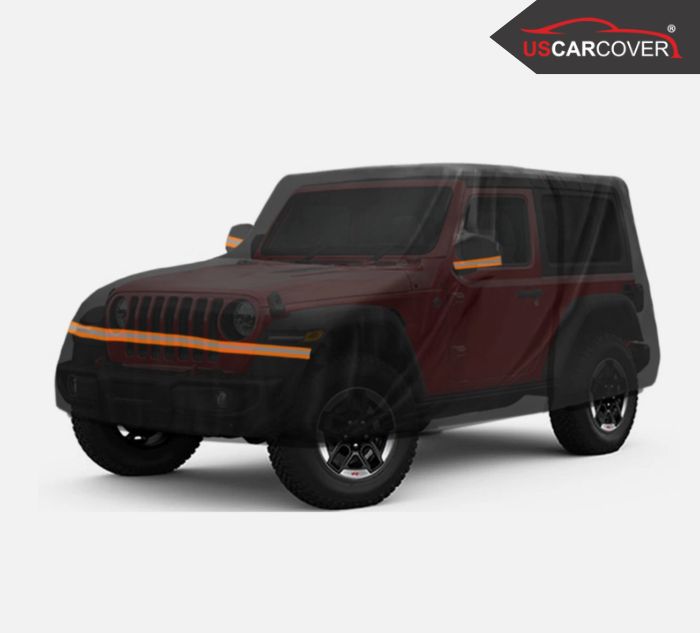
Related Articles: Infiniti car cover: a proactive solution against harsh sun, showers, fine dust and humidity
Showers, sprinklers, and lingering humidity: gentle but stubborn
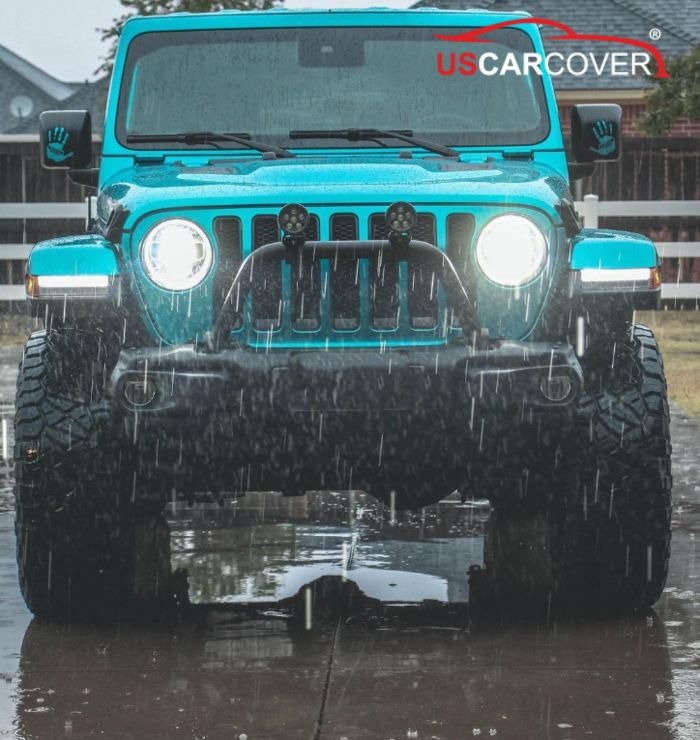
A brief shower or morning sprinkler feels harmless, yet it leaves hundreds of droplets along glass edges, lamp perimeters, and grilles. When the sun returns, water evaporates and dissolved minerals crystallize into white rings. After a few days the glass looks dull, wipers chatter and streak, and headlamp optics scatter more. At the same time, humidity gets trapped in seams and corners, so the cabin carries a faint damp odor and chrome loses depth.
The cause is extended wet time and a lack of a vapor exit. The consequence is mineral halos, odor, and a flat, dull look on brightwork. The fix is to shorten wet time and open a vapor path. A beading outer surface forces droplets to gather and slide quickly along body slopes so minerals have little time to crystallize. A one-way breathable core lets vapor travel from the underside out while rain does not travel down, which keeps the underside dry day after day. When humid wind arrives, a stable form prevents the fabric from ballooning and collapsing that would otherwise drag dust across the glass. If you park overnight in the driveway, this is how a Jeep car cover spares you the daily water-spot battle.
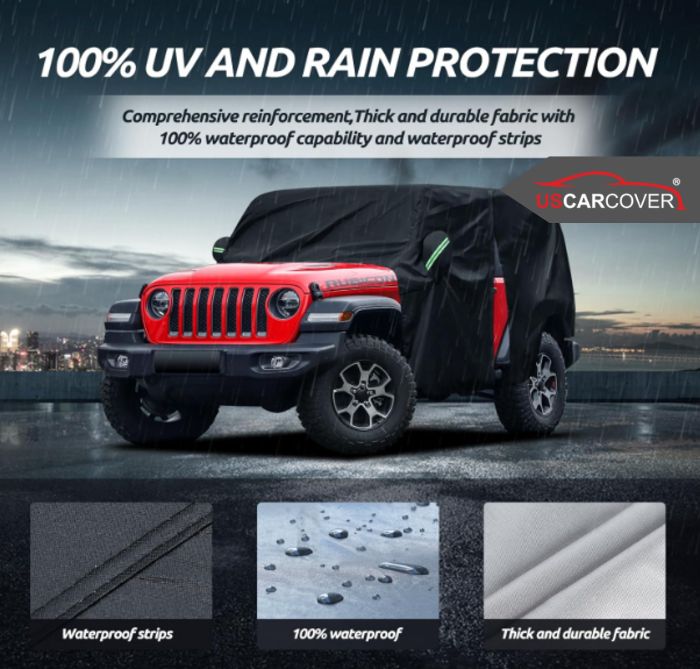
Related Articles: Ineos car cover: Always protect your vehicle in every harsh environment
Deep snow and road salt: a corrosion loop that must be cut in the right place

In the Snow Belt, snow travels with salt. Meltwater carries salt into seams and evaporates, leaving salt behind that pulls moisture back in. The wet-dry cycle repeats, accelerating pitting on chrome, steps, and hinges. Seals face thermal shock from cold to warm and turn brittle. If the cover is not breathable, a cold, damp greenhouse forms underneath and speeds the damage.
The cause is a salt-maintained moisture loop and trapped humidity. The consequence is pitting, dull surfaces, and aged seals. The solution has three parts. Strong beading so meltwater slides off quickly and wet time shrinks. A stable form so ice crystals and salt are not rubbed around repeatedly. Breathability so moisture does not stay trapped under the cover. After salty spells, shake the cover to drop salt, rinse with fresh water, and air dry before rolling. This small discipline protects both the cover and the chrome all winter.
Related Articles: Hyundai car cover: New fabric technology for sun, rain, snow and scratch protection
Choosing a Jeep car cover by climate and parking habit in the United States
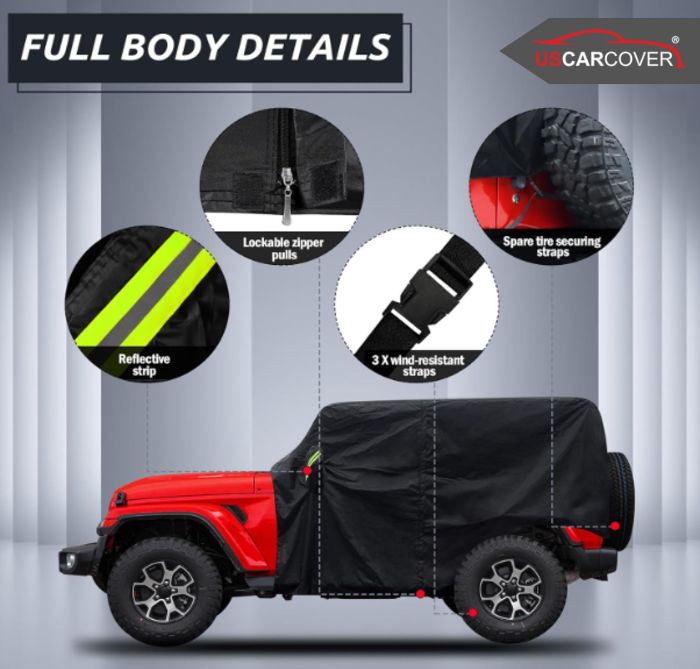
Good decisions start with three simple questions: where do you park, how long, and under what conditions:
- Sun Belt with harsh sun. Prioritize stable UV resistance and radiation reflectivity, paired with breathability to cool the cabin for real. If you often stop 30 to 90 minutes, a half cover that shades glass and roof is quick and effective. For long or overnight parking, a full cover adds dust and wind control.
- Pacific Northwest with long rain and morning sprinklers. You need beading to defeat water spots and breathability to keep the underside from staying damp. After a rainy stretch, crack one edge for a few minutes to exchange air, then close again.
- Gulf Coast and other coastal zones with salty humidity. True breathability is mandatory to avoid a salty greenhouse. Keep the rhythm of shaking off salt, fresh-water rinsing, and air drying.
- Snow Belt with snow and road salt. Combine strong beading with a stable form so salt and crystals are not rubbed around. Always shake salt out before rolling.
- High plains with strong wind and desert dust. Emphasize a stable form, recessed seams and soft hems, and an ultra soft lining to eliminate repeated friction.
Parking habits matter as much as climate. Frequent short stops favor a half cover that is easy to use, which means you will use it often. Long, overnight, or outdoor storage needs a full outdoor cover with the full mechanism set. Indoor storage in a garage calls for an indoor cover that focuses on soft lining and gentle moisture balance.
Related Articles: Hupmobile car cover: full coverage, interior protection, anti-mold and anti-rust to keep your car looking new
Custom fit: big differences come from a correct form
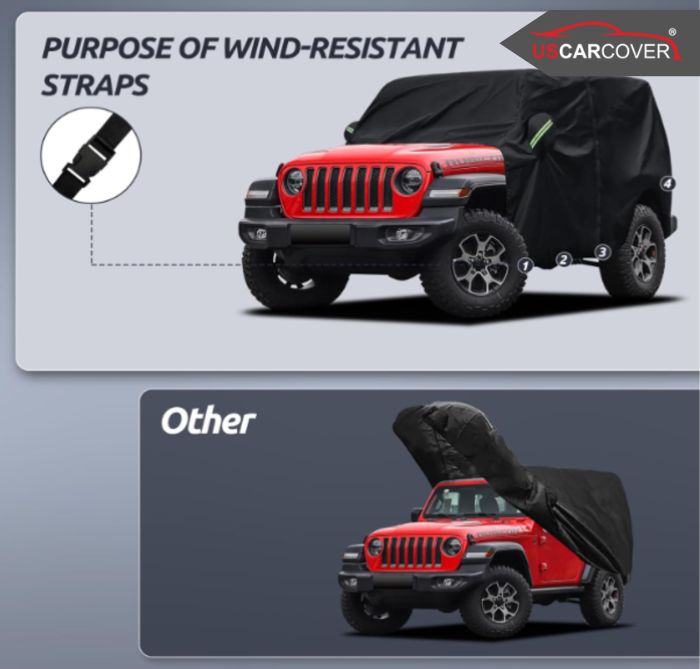
Wrangler with two doors differs from four doors, Gladiator has a long bed, Grand Cherokee has a different rear glass slope, Renegade and Compass are more compact, and accessories like roof racks, steel bumpers, winches, light bars, and snorkels change the airflow and anchor points. A Jeep car cover that is custom fit forms air pockets correctly at the base of the windshield and on the roof, distributes tension and slack so the cover does not puff and collapse, hides seam edges at transitions, and uses soft hems so upright glass avoids edge prints. With soft tops, an ultra soft lining is essential because soft windows scratch more easily than hard glass. With matte paint, PPF, or ceramic coatings, the soft lining plus stable form let the two layers of protection complement each other. The cover eliminates repeated friction while the coating adds slickness and soil resistance.
Long term value: small money now to cut big bills later
Add it up by season. Polishing to erase micro swirls thins the clear coat. De-spotting glass costs time and risks micro scratching if pads are wrong. Re-brightening chrome must be repeated if salty humidity remains. Plastic, seals, and leather need extra care if UV still hits every morning. Headlamp correction or replacement takes the vehicle out of service. When a Jeep car cover cuts UV, water, humidity, wind, and dust at the source, the frequency of those jobs drops. You keep a fresh look each time you open the door, save time and money, and preserve resale value.
Where to buy a quality Jeep car cover

A good Jeep car cover is the sum of materials, mechanisms, and an understanding of how owners in the United States actually park. At US Car Cover, you can find outdoor Jeep car cover configurations with a consistent beading surface, a one-way breathable core, an ultra soft lining that is safe for paint, glass, and chrome, and custom-fit forms for Wrangler, Gladiator, Grand Cherokee, Renegade, and Compass. You also get guidance by climate, including Sun Belt, Pacific Northwest, Gulf Coast, and Snow Belt, and by parking duration, short or long, to choose the right half or full cover. When the mechanism is correct and the form is true, putting on and removing the cover takes one to two minutes. Because it is easy, you use it often, and that habit is exactly what creates compounding protection week after week and season after season.
Related Articles: Hummer car cover for indoor or outdoor: choose based on needs, climate, parking context, and off-road frequency
one proactive mechanism for four harsh scenarios
The opening question was how a Jeep car cover can handle red mud, desert dust, sudden showers, and deep snow at the same time. The answer is condition management, not only coverage. Beading shortens wet time so minerals do not print. Breathability breaks the humidity greenhouse so the cabin and chrome are not stewed. UV resistance cuts long radiation so plastics, lamps, and leather keep their color. An ultra soft lining and stable form eliminate repeated friction so paint and glass avoid micro swirls. When these links operate together, surfaces stay clean with fewer marks, glass remains clear, chrome keeps its depth, the cabin stays cooler and odor-free. Financially, this is how a small investment in a Jeep car cover becomes large savings on polishing, de-spotting, material care, and downtime. Whether you make a quick mid-day stop at a trailhead, leave the car overnight under showers, or park long in salt and snow, let the harshness be the backdrop. Your Jeep stays the main character, beautiful, durable, and always ready for the next journey.
